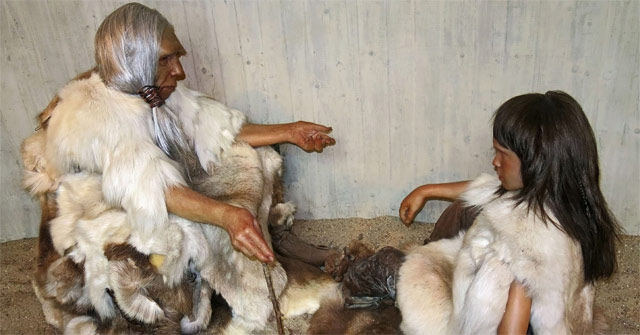When did people start wearing 'clothes'?
In the early days, when humans began to stand upright, the 'Cradle of Humanity' in Africa had the perfect climate, making it so that our ancestors did not need to wear clothes to keep their bodies warm, and at the same time they did not need to wear clothes to keep themselves warm. need thick fur like many other animals. But to conquer new lands, from Europe to Asia, there was a time when our ancestors had to take skins peeled from the prey they hunted and put them on their bodies to keep their bodies warm.

According to archaeologists, they found evidence of the earliest time human ancestors were not 'naked' in archaeological areas such as Gran Dolina in the Atapuerca Mountains in Spain, related to Homo sapiens. the antecessor dates back to about 780,000 years ago. Some other evidence was found in Schöningen, Germany, related to Homo heidelbergensis. In Germany, archaeological evidence shows that at least 400 thousand years ago, upright humans knew how to process skins to turn them into clothes to wear on their bodies.
By the era of the Neanderthals, dating from about 400,000 years ago, until about 40,000 years ago, archaeologists discovered muscle structures on the forearms and biceps of Neanderthals showing that they often had to perform The movement is like putting a skin on your body. Despite being better adapted to the cold than Homo sapiens, a 2012 study demonstrated that Neanderthals had to cover up to 80 percent of their body to survive. harsh winters.
Now in the winter, we have to wear clothes that cover 90 percent of our body, even wearing many layers of clothing to keep warm. And the fact that humans use clothes itself is also inferred from the fact that a 2011 study showed that lice on clothes have mutated from lice that lived in human hair about 170,000 years ago. This number, if deduced, also means the first time people wore clothes from different materials, not just skins worn on the body to keep the body warm.
More specifically, according to Wikipedia, Ralf Kittler, Manfred Kayser and Mark Stoneking, anthropologists at the Max Planck Institute for Evolutionary Anthropology, conducted genetic analysis of lice on human bodies showing that clothing originated from from about 170,000 years ago. Body lice are a sign of clothing, as most humans have sparse body hair, and therefore lice need human clothing to survive. Their research suggests that the invention of clothing may have coincided with the northward migration of modern Homo sapiens from the warm climates of Africa, thought to have begun 50,000 to 100,000 years ago. before. However, a second group of researchers using similar genetic methods estimated that clothing originated about 540,000 years ago.
According to archaeologists and anthropologists, the earliest clothing may have consisted of fur, leather, leaves or grass covered, wrapped or tied around the body. Knowledge about such clothing remains speculative, as clothing materials quickly degrade compared to stone, bone, shell, and metal artifacts. Archaeologists have identified very early bone and ivory sewing needles from around 30,000 BC, found near Kostenki, Russia in 1988. Dyed flax fibers can be used in clothing was found in a prehistoric cave in the Republic of Georgia dating back to 34,000 BC.
Some other archaeological evidence shows that, about 40 thousand years ago, people knew how to use sewing needles made from bone and stone to piece together pieces of skin to fit the body, helping to keep the body warm. more effective.
- A warning for those who do not wash new clothes before wearing
- When did people start dressing?
- Be aware of the clothes you wear - it can change your life
- Clothes worn for weeks without washing
- The habit of causing harm to the cold day
- Wearing bright colored shirts will be cooler when going on a sunny day
- Continuously dig graves, wear new clothes and process dead people around the village
- Women are more jealous when you are in the same gender wearing red?
- The mystery of the person who returned 18 months after being swept away by the waves, still wearing the same clothes as when the accident happened
- Men like women wearing red
- Strange superstitions in the world
- Why do your clothes often have fake bags? Very simple reason!
 Discovered an ancient centipede fossil 99 million years old
Discovered an ancient centipede fossil 99 million years old Discovered bat-like dinosaurs in China
Discovered bat-like dinosaurs in China Discovered a 200-year-old bronze cannon of the coast
Discovered a 200-year-old bronze cannon of the coast Discover 305 million-year-old spider fossils
Discover 305 million-year-old spider fossils Excavating the tomb, the archaeological team was terrified to see the mummy that had woken up in the coffin.
Excavating the tomb, the archaeological team was terrified to see the mummy that had woken up in the coffin.  What happens to dead bodies on Mars?
What happens to dead bodies on Mars?  How long does it take and how hot does it have to be to burn a body to ashes?
How long does it take and how hot does it have to be to burn a body to ashes?  Top 10 most powerful and surviving animals on the planet
Top 10 most powerful and surviving animals on the planet  Stunned to discover strange, mysterious creatures in Antarctica
Stunned to discover strange, mysterious creatures in Antarctica  Daily habits that are harmful to health that 90% of people have but think they are doing the right thing
Daily habits that are harmful to health that 90% of people have but think they are doing the right thing 